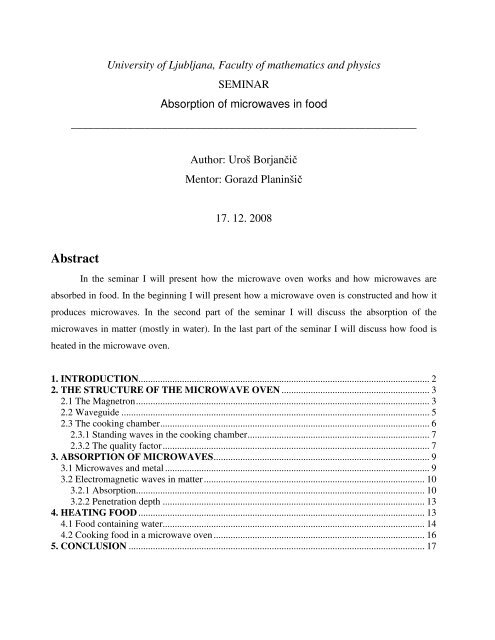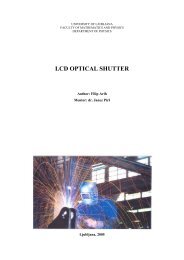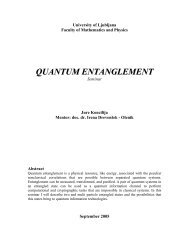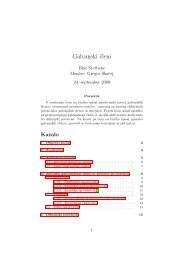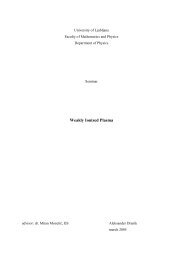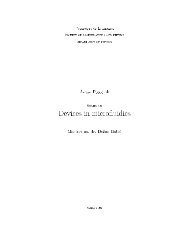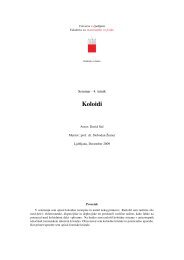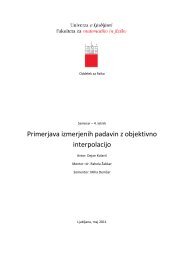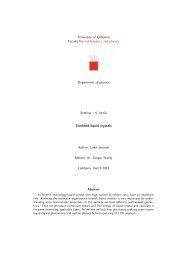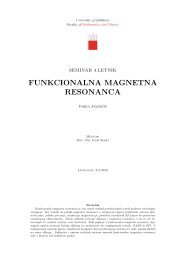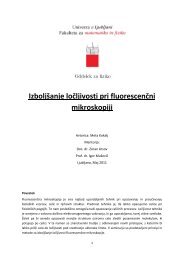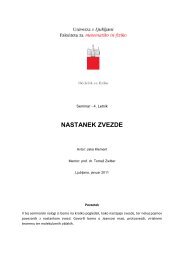3. absorption of microwaves
3. absorption of microwaves
3. absorption of microwaves
You also want an ePaper? Increase the reach of your titles
YUMPU automatically turns print PDFs into web optimized ePapers that Google loves.
University <strong>of</strong> Ljubljana, Faculty <strong>of</strong> mathematics and physics<br />
SEMINAR<br />
Absorption <strong>of</strong> <strong>microwaves</strong> in food<br />
_____________________________________________________________<br />
Abstract<br />
Author: Uroš Borjančič<br />
Mentor: Gorazd Planinšič<br />
17. 12. 2008<br />
In the seminar I will present how the microwave oven works and how <strong>microwaves</strong> are<br />
absorbed in food. In the beginning I will present how a microwave oven is constructed and how it<br />
produces <strong>microwaves</strong>. In the second part <strong>of</strong> the seminar I will discuss the <strong>absorption</strong> <strong>of</strong> the<br />
<strong>microwaves</strong> in matter (mostly in water). In the last part <strong>of</strong> the seminar I will discuss how food is<br />
heated in the microwave oven.<br />
1. INTRODUCTION........................................................................................................................ 2<br />
2. THE STRUCTURE OF THE MICROWAVE OVEN ............................................................. 3<br />
2.1 The Magnetron......................................................................................................................... 3<br />
2.2 Waveguide ............................................................................................................................... 5<br />
2.3 The cooking chamber............................................................................................................... 6<br />
2.<strong>3.</strong>1 Standing waves in the cooking chamber........................................................................... 7<br />
2.<strong>3.</strong>2 The quality factor.............................................................................................................. 7<br />
<strong>3.</strong> ABSORPTION OF MICROWAVES......................................................................................... 9<br />
<strong>3.</strong>1 Microwaves and metal ............................................................................................................. 9<br />
<strong>3.</strong>2 Electromagnetic waves in matter........................................................................................... 10<br />
<strong>3.</strong>2.1 Absorption....................................................................................................................... 10<br />
<strong>3.</strong>2.2 Penetration depth ............................................................................................................ 13<br />
4. HEATING FOOD ...................................................................................................................... 13<br />
4.1 Food containing water............................................................................................................ 14<br />
4.2 Cooking food in a microwave oven....................................................................................... 16<br />
5. CONCLUSION .......................................................................................................................... 17
1. INTRODUCTION<br />
In the Western world almost every kitchen has a microwave oven. We use it every day for<br />
heating food without asking ourselves what actually happens in there. In the seminar I will try to<br />
explain what happens in the cooking chamber and why. Microwaves are electromagnetic waves.<br />
Their frequencies are in the range from 300 MHz up to 300 GHz (or in wavelength: 1mm – 1m)<br />
(figure 1) [1].<br />
Figure 1 Spectrum [1].<br />
As we can see, the wavelength <strong>of</strong> the <strong>microwaves</strong> is not in the range <strong>of</strong> mm, as we might<br />
expect from their name. Following international conventions, microwave ovens at home operate at<br />
frequencies <strong>of</strong> about 2,45 GHz ( λ = 12, 23 cm) [2]. The story <strong>of</strong> the microwave cookery started<br />
back in 1945 when an American scientist Percy L Spencer (figure 2 left) [3], working with a high<br />
intensity magnetron microwave generator, noticed something strange while passing near to the<br />
magnetron. He noticed that a chocolate bar in his pocket had melted. He soon demonstrated the<br />
cooking effect <strong>of</strong> the <strong>microwaves</strong>. The first microwave ovens cost between 2000 and 3000 dollars<br />
and were the size <strong>of</strong> a refrigerator (Figure 2 right). The magnetron had to be cooled by water. In<br />
1967 a 100-volt microwave oven was invented. It<br />
was smaller and cost a little less than 500 dollars.<br />
By 1975 4% <strong>of</strong> US homes used microwave cookers,<br />
in 1976 the percentage reached 60% and in 2003,<br />
95% <strong>of</strong> US homes had a microwave cooker.<br />
Figure 2 Percy Spencer (left) and the first<br />
commercial microwave oven (right) [3].<br />
2
2. THE STRUCTURE OF THE MICROWAVE OVEN<br />
Modern microwave ovens are approximately 40 cm large, 40 cm wide and 30 cm high.<br />
There are three basic components <strong>of</strong> a microwave oven. Microwaves are generated in the<br />
magnetron and then led through the waveguide into the cooking chamber (figure 3)[2].<br />
2.1 The Magnetron<br />
Figure 3 The inside looking <strong>of</strong> a microwave oven [2]<br />
The most powerful <strong>microwaves</strong> produced by solid state devices (used in cell phones) are<br />
too weak for cooking. The generator <strong>of</strong> <strong>microwaves</strong> in microwave ovens is the magnetron. The<br />
magnetron or more exactly the magnetron vacuum tube is a high-voltage system like the roentgen<br />
and the cathode tube. From AC line voltage is transformed and reflected to get very high DC<br />
voltage [4]. It can generate continuous or pulsed microwave beams with frequencies between 1<br />
and 40 GHz. The basic internal structures <strong>of</strong> the magnetrons are (picture 4):<br />
- The anode is a hollow cylinder <strong>of</strong> iron which has an even number <strong>of</strong> anode vanes<br />
inside. Those are called resonant cavities. In microwave ovens they are trapezoidal or<br />
cylindrical shaped areas designed to resonate at 2450 MHz. The anode operates in<br />
such a way that alternate segments must be connected, or strapped, so that each<br />
segment is opposite in polarity to the segment on either side. In effect, the cavities are<br />
connected in parallel with regard to the output.<br />
- The cylindrical cathode is located in the centre <strong>of</strong> the magnetron several millimetres<br />
from the anode. The cathode is supported by the large and rigid filament leads, which<br />
are carefully sealed into the tube and shielded.<br />
3
- The antenna is probe or a loop which is connected to the anode and extends into one<br />
<strong>of</strong> the resonant cavities. The antenna is coupled to the waveguide which transmits the<br />
RF energy.<br />
- Strong permanent magnets create a parallel magnetic field parallel with the axis <strong>of</strong><br />
the cathode.<br />
Figure 4 Basic structure <strong>of</strong> the magnetron (right). The effect <strong>of</strong> the electric and<br />
magnetic field (A to D) [4].<br />
A voltage <strong>of</strong> several kV is applied between the electrodes. At first the electrons accelerate<br />
radially, but then the magnetic field bends their motion. They never reach the anode, but they form<br />
a rotating space charge. This effect is caused by the Lorentz force:<br />
<br />
v<br />
F = e( E + cβ × B),<br />
β = ,<br />
c<br />
where E is the electric field and B is the magnetic field. The accelerated motion <strong>of</strong> the electrons<br />
produces electromagnetic motion, which begins to resonate in the resonant cavities <strong>of</strong> the anode.<br />
That interacts with the electrons by either accelerating or decelerating them [2]. This leads to<br />
electron bunches, which move around the cathode at microwave frequencies. Eventually we get<br />
self-sustaining oscillations in the resonant cavities.<br />
4<br />
(1)
Every single cavity works as a resonant circuit (figure 5). The resonant frequency <strong>of</strong> a<br />
microwave cavity is thereby determined by the physical dimension <strong>of</strong> the resonator, which<br />
determines the capacitance C and inductance L [5].<br />
Figure 5 Resonant circuit [5].<br />
The currents around the resonant cavities cause them to radiate electromagnetic energy at a<br />
resonant frequency: ν = 1 LC , which is around 2,45 GHz.<br />
res<br />
The magnetron is an efficient device. In a microwave oven an 1100 to 1200 watt input will<br />
generally create about 700 to 800 watts <strong>of</strong> microwave energy, efficiency is between 60 and 70%.<br />
2.2 Waveguide<br />
The antenna transmits the RF energy into the waveguide. Waveguides are metal tubes <strong>of</strong><br />
rectangular cross section. The metal reflects the <strong>microwaves</strong>. Consequently (because <strong>of</strong> the<br />
boundary conditions in the tube), it leads to electric and magnetic field distribution.<br />
Electromagnetic waveguides are analyzed by solving Maxwell's equations [6]. In waveguides we<br />
get some sort <strong>of</strong> standing waves determined by boundary conditions, therefore hollow waveguides<br />
must be one-half wavelength or more in diameter, in order to support one or more transverse wave<br />
modes.<br />
Figure 6 Flexible waveguide from a J-Band radar (left). The electric field<br />
distribution <strong>of</strong> a rectangular hollow metallic waveguide (right).<br />
5
A microwave oven waveguide’s inner tube filled with air and operating at 2450 MHz must have at<br />
least one inner dimension larger than max 2<br />
λ where max<br />
6<br />
λ = 12, 2 cm. Only one inner dimension <strong>of</strong><br />
the cross section <strong>of</strong> the waveguide has larger dimension than λ max 2 . Therefore the <strong>microwaves</strong><br />
leaving the waveguide are polarized.<br />
2.3 The cooking chamber<br />
The place where we heat the food is called the cooking chamber [2]. The chambers are<br />
3<br />
usually <strong>of</strong> dimensions around 30× 30× 20 cm . They have metallic walls that act as a Faraday’s<br />
cage. The front door is made <strong>of</strong> glass and covered with a metal grid. Inside there is usually an<br />
electric bulb also covered with a metallic grid. The metallic walls reflect the <strong>microwaves</strong>.<br />
Therefore the waves resonate and form standing waves. Standing waves have nodes and antinodes.<br />
That is the reason why food that we heat in the microwave ovens is not heated uniformly (figure<br />
7). For cooking more efficiently we have a rotating plate inside the cooking chamber. The rotation<br />
moves food in and out <strong>of</strong> the hot spots. Some ovens have a mode stirrer that is a rotating reflector<br />
at the top to get a more homogenous field distribution.<br />
Figure 7 Visualization <strong>of</strong> the horizontal hot and cold spots in microwave<br />
oven using infrared thermal imagining. Cooking chamber dimensions:<br />
3<br />
29× 29× 19 cm . A glass plate with a thin water film was placed at a height <strong>of</strong><br />
8 cm and heated for 15 s with a microwave power <strong>of</strong> 800 W without using the<br />
rotating plate [2].
2.<strong>3.</strong>1 Standing waves in the cooking chamber<br />
In the cooking chamber we get three-dimensional standing waves:<br />
1 1 1 1<br />
= + + . (2)<br />
λ λ λ λ<br />
2 2 2 2<br />
x y z<br />
λ is the wavelength <strong>of</strong> <strong>microwaves</strong>, λ x,<br />
λ y and λ z are determined by the size <strong>of</strong> the chamber:<br />
As we can see there more than one way to satisfy equation (2).<br />
λ<br />
[cm]<br />
2.<strong>3.</strong>2 The quality factor<br />
x<br />
y<br />
Lx l , Ly m<br />
2 2<br />
λ<br />
λ<br />
z<br />
= = and Lz n<br />
2<br />
λ<br />
= . (3)<br />
Table 1 All modes <strong>of</strong> microwave oven <strong>of</strong><br />
dimensions<br />
7<br />
3<br />
29× 29× 19 cm with the wave-<br />
length range between 12 cm and 12,5 cm.<br />
Four <strong>of</strong> the solutions are quite close to the<br />
magnetron wavelength, which is 12,23 cm.<br />
In every physical system there are energy losses. The lost energy has to go somewhere.<br />
What could actually happen with <strong>microwaves</strong>? Microwaves may escape through the housing <strong>of</strong> the<br />
oven, but this contribution is very small. Also the walls could absorb some energy. When we heat<br />
food it absorbs <strong>microwaves</strong>. There is also a chance that <strong>microwaves</strong> are reflected back into the<br />
magnetron. That shortens the lifetime <strong>of</strong> the magnetron and it could happen if the microwave oven<br />
is turned on when empty.<br />
l m n<br />
12,103 1 1 3<br />
12,274 2 4 1<br />
12,274 4 2 1<br />
12,277 2 3 2<br />
12,277 3 2 2<br />
12,375 0 1 3<br />
The quality factor Q is a measure <strong>of</strong> the energy loss and it gives the ratio <strong>of</strong> the energy<br />
stored in the resonator and the energy loss per cycle (it compares the frequency at which a system<br />
oscillates to the rate at which it dissipates its energy):<br />
ωE<br />
Q = ω = 2 πν ,<br />
(4)<br />
( dE dt)
ν is the frequency <strong>of</strong> the <strong>microwaves</strong>. A higher Q indicates a lower rate <strong>of</strong> energy dissipation<br />
relative to the oscillation frequency, so the oscillations die out more slowly. The whole quality<br />
factor can be calculated from:<br />
1 1 1<br />
= + +… ,<br />
(5)<br />
Q Q Q<br />
1 2<br />
where Q1, Q2, … are quality factors <strong>of</strong> energy losses in the system (<strong>absorption</strong> <strong>of</strong> the walls,<br />
heating <strong>of</strong> food, …). The most important losses in an empty oven are the wall losses. They can be<br />
estimated from the penetration depth δ (more about it later in the seminar):<br />
Q<br />
empty<br />
8<br />
V<br />
≈ , (6)<br />
Sδ<br />
where V is the volume <strong>of</strong> the cooking chamber and S the inner surface. The quality factor <strong>of</strong> an<br />
3<br />
empty microwave oven ( 30 30 20 cm )<br />
order <strong>of</strong><br />
order <strong>of</strong><br />
× × , with penetration depth <strong>of</strong> the walls δ ≈ 1µ m , is <strong>of</strong> the<br />
4<br />
10 , while when we put a glass <strong>of</strong> water inside the chamber the quality factor is <strong>of</strong> the<br />
2<br />
10 . If we put more water in the chamber, the quality factor would be lower and the<br />
<strong>absorption</strong> would be greater.
<strong>3.</strong> ABSORPTION OF MICROWAVES<br />
As I mentioned before, food is heated by absorbing the energy. Electromagnetic waves can<br />
be absorbed in many different ways. For example, atoms absorb UV electromagnetic waves, solid<br />
materials usually absorb infrared radiations. While the microwave radiation passes through food, it<br />
gets absorbed by it. Liquid substances in food absorb energy in a process called dielectric heating.<br />
Many molecules (such as those <strong>of</strong> water) are electric dipoles and have a positive charge at one end<br />
and a negative charge at the other. Because <strong>of</strong> that they try to align themselves with the external<br />
electric field (figure 8). Electric dipoles in the external oscillating field rotate in order to stay<br />
aligned with the field. That is exactly what happens in microwave ovens. This molecular<br />
movement creates heat as the rotating molecules hit other molecules and put them into motion.<br />
Microwave heating is more efficient on liquid water than on fats and sugars (which have less<br />
molecular dipole moment) [6].<br />
Figure 8 The orientation <strong>of</strong> the dipole moment in the external electric field.<br />
<strong>3.</strong>1 Microwaves and metal<br />
As the mirror reflects the visible light, the metal reflects the <strong>microwaves</strong>. The nearly free<br />
electrons on the surface <strong>of</strong> the metal absorb the microwave radiation, which accelerates them and<br />
then the accelerated electrons re-radiate electromagnetic waves at the same frequency and in<br />
phase. That acts like a mirror [2]. If we put a metallic object in the oven, we can see flash<br />
lightening inside. Thin metallic objects can also have electric charges build up on their sharp<br />
points. The charge comes from nearly free electrons in metal that move in an alternating electric<br />
field. If enough electric charge builds up on a sharp, air can briefly conduct electricity. That<br />
happens if the electric field reaches the breakthrough value (for air: ~ 30 kV cm ). An electric spark<br />
arcs to the nearest other electrical conductor. Metal inside a microwave oven will not harm food or<br />
make it unsafe to eat, but the electrical sparks could damage the oven.<br />
pe <br />
9<br />
Eext
<strong>3.</strong>2 Electromagnetic waves in matter<br />
<strong>3.</strong>2.1 Absorption<br />
If we want to understand the whole concept <strong>of</strong> the <strong>absorption</strong> <strong>of</strong> <strong>microwaves</strong>, we have to<br />
begin with the Maxwell’s equations for the electromagnetic waves [8]:<br />
<br />
1. ∇ ⋅ D = 0,<br />
<br />
∂D <strong>3.</strong> ∇× H = j + ,<br />
∂t <br />
2. ∇ ⋅ B = 0<br />
<br />
∂B<br />
. (7)<br />
4. ∇× E = −<br />
∂t<br />
<br />
j = σ E, <br />
D = εε E<br />
<br />
B = µµ H , where ε is the dielectric constant, σ is the<br />
Considering 0<br />
and 0<br />
conductivity (Ohm’s law) and µ is the permeability, we can transform Maxwell’s:<br />
<br />
1. ∇ ⋅ E = 0, 2. ∇ ⋅ H = 0<br />
<br />
∂E ∂H<br />
. (8)<br />
<strong>3.</strong> ∇× H = σ E + εε 0 , 4. ∇× E = −µµ<br />
0<br />
∂t ∂t<br />
Let’s take the curl <strong>of</strong> the Ampere’s law in the equations (8):<br />
<br />
⎛ ∂H ⎞ ∂ <br />
∇× ( ∇× E) = ∇× ⎜ − µµ 0 ⎟ = −µµ 0 ( ∇× H )<br />
⎝ ∂t ⎠ ∂t<br />
<br />
∂ ∂ ⎛ ∂E<br />
⎞<br />
− µµ 0 ( ∇× H ) = − µµ 0 ⎜σ E + εε 0 ⎟ ⇒<br />
∂t ∂t ⎝ ∂t<br />
⎠<br />
2<br />
∇× ∇× E = ∇ ∇ ⋅ E − ∇ E<br />
( ) ( )<br />
10<br />
<br />
<br />
2<br />
2 ∂E ∂ E<br />
∇ E = µµ 0σ + µµ 0εε 0 2<br />
∂t ∂t<br />
, (9)<br />
which is the wave equation in a conducting medium. We can derive a similar equation for the<br />
magnetic field:<br />
<br />
<br />
2<br />
2 ∂B ∂ B<br />
∇ B = µµ 0σ + µµ 0εε 0 2<br />
∂t ∂t<br />
. (10)<br />
Propagations <strong>of</strong> the electric and magnetic field in complex notations are given by equations:<br />
<br />
<br />
E ( r, t) E0 exp ⎡<br />
<br />
= i( ωt<br />
k r ) ⎤<br />
⎣<br />
− ⋅<br />
⎦<br />
<br />
<br />
B ( r, t) = B0 exp ⎡<br />
<br />
. (11a, 11b)<br />
i ( ωt<br />
− k ⋅r<br />
) ⎤<br />
⎣ ⎦<br />
If we differentiate the equation (11a) and insert it in the equation (9), we get<br />
2 2 ⎛ σ ⎞ <br />
2 2<br />
∇ E + ω µµ 0 εε 0 − i E = ( ∇ + k̃ ⎜ ⎟<br />
) E = 0 , (12)<br />
⎝ ω ⎠
where k̃ is the complex propagation vector: 2 2<br />
k 0 0 i ,<br />
0<br />
σ<br />
̃<br />
⎛ ⎞<br />
= ω µµ ε ⎜ε − ⎟ from which we get the<br />
⎝ ωε ⎠<br />
complex dielectric constant:<br />
σ<br />
̃ ε = ε − i = ε1 − iε<br />
2 . (13)<br />
ωε<br />
The complex dielectric constant is important because <strong>of</strong> the index <strong>of</strong> refraction, which is given<br />
from: 0<br />
0<br />
k̃ = ñ ω c where ( ) 1 −<br />
c = µ ε represents the velocity <strong>of</strong> the electromagnetic waves in<br />
0 0 0<br />
vacuum. The complex index <strong>of</strong> refraction is then:<br />
ñ = µε̃<br />
& ñ = n − in<br />
( 1 )<br />
11<br />
1 2<br />
ñ = n − iκ . (14)<br />
κ is called extinction coefficient and nκ the <strong>absorption</strong> coefficient. We assume that the<br />
propagation vector is parallel to the z axis (the direction <strong>of</strong> the propagation <strong>of</strong> the wave). By<br />
transforming the equation (11a) we get:<br />
The real part <strong>of</strong> E is:<br />
E 0<br />
⎡ ωnκ ⎤ ⎡ ⎛ n ⎞⎤<br />
E ( z, t) = E0 exp ⎡i ( ωt − k̃ ⋅ z) ⎤ = E0 exp − z exp ⎢iω t − z<br />
⎣ ⎦ ⎢ ⎥ ⎜ ⎟⎥<br />
,<br />
⎣ c0 ⎦ ⎣ ⎝ c0<br />
⎠⎦<br />
2<br />
1.5<br />
1<br />
0.5<br />
0<br />
-0.5<br />
-1<br />
-1.5<br />
⎡ ωnκ ⎤ ⎛ ωn<br />
⎞<br />
E ( z, t) = E0 exp ⎢− z⎥ cos⎜<br />
ωt<br />
− z ⎟ . (15)<br />
c c<br />
Matter<br />
Vacuum Matter<br />
⎣ 0 ⎦ ⎝ 0 ⎠<br />
-2<br />
-5 0 5 10<br />
Graph 1 Decreasing <strong>of</strong> the amplitude <strong>of</strong> the electric field in matter. Qualitative<br />
interpretation <strong>of</strong> the equation (15).<br />
z
The wave described by (15) is a plane wave, attenuated by the exponent. Combining the equations<br />
(13), (14) and the equation for the propagation vector we get<br />
From these two relationships we get<br />
2 ⎛ σ ⎞<br />
2 2 2 µσ<br />
ñ = µ ⎜ε − i ⎟ ⇒ n ( 1 − κ ) = µε, 2 n κ = .<br />
⎝ ωε 0 ⎠<br />
ωε 0<br />
⎛ 2<br />
2 1 2 2 ⎛ µσ ⎞<br />
⎞<br />
µ 2 2<br />
= ⎜ µ ε + + µε ⎟ ⇒ 1 = ε1 + ε 2 + ε1<br />
2 ⎜<br />
⎜ ⎟<br />
ωε ⎟<br />
0<br />
2<br />
n n<br />
⎝<br />
⎝ ⎠<br />
⎠<br />
12<br />
( )<br />
⎛ 2<br />
2 2 1 2 2 ⎛ µσ ⎞<br />
⎞<br />
µ 2 2<br />
κ = ⎜ µ ε + − µε ⎟ ⇒ 2 = ε1 + ε 2 −ε<br />
1<br />
2 ⎜<br />
⎜ ⎟<br />
ωε ⎟<br />
0<br />
2<br />
n n<br />
⎝<br />
⎝ ⎠<br />
⎠<br />
( )<br />
. (16a, 16b)<br />
Absorption mostly depends on the imaginary part <strong>of</strong> the dielectric constant. Let’s take the<br />
example where conductivity equals zero and therefore κ = 0 . The equation (16a) gives us the<br />
= µε ⇒ = µε . At this point it is clear that electromagnetic waves can be<br />
solution: n n1<br />
1<br />
absorbed only if the imaginary part <strong>of</strong> the dielectric constant equals zero: ε 2 = 0 .<br />
Figure 9 The real ( ε 1)<br />
and imaginary ( 2 )<br />
various kinds <strong>of</strong> food [2].<br />
ε part <strong>of</strong> the dielectric constant for
For getting more familiar with the numbers let’s take for instance copper for<br />
microwave wavelength ( λ = 12, 23cm)<br />
, which has<br />
ω πc λ<br />
10 −1<br />
= 2 0 = 1,54 ⋅ 10 s :<br />
6 −1 −1<br />
µσ 1⋅59,6 ⋅10<br />
AV m<br />
= ≈ 4,4 ⋅10<br />
10 −1 −12 −1 −1<br />
ωε 1,54 ⋅10 s ⋅8,85 ⋅10<br />
AsV m<br />
0<br />
13<br />
µ ~ 1, ε ~ 1, σ 59,6 10 m<br />
8<br />
6 −1 −1<br />
= ⋅ Ω and<br />
and µε ≈ 1.<br />
Copper is a conductor and for conductors we can assume µσ ωε 0 >> µε . For conductors we can<br />
make the approximation:<br />
<strong>3.</strong>2.2 Penetration depth<br />
µσ<br />
nκ<br />
= .<br />
(17)<br />
2ωε<br />
Penetration depth δ is defined as a value <strong>of</strong> z where the amplitude <strong>of</strong> the wave drops to<br />
1 e <strong>of</strong> its original value. We find it out from the first exponent in the equation (15):<br />
⎡ ωnκ ⎤<br />
exp ⎢− z⎥<br />
→ the exponent will equal 1:<br />
c<br />
⎣ 0 ⎦<br />
ωnκ δ = 1 ⇒<br />
c<br />
0<br />
λ λ<br />
δ = = . (18)<br />
2π nκ 2π<br />
n<br />
4. HEATING FOOD<br />
2<br />
0<br />
Kind <strong>of</strong> food δ [cm] Kind <strong>of</strong> food δ [cm]<br />
Raw pork 16 peas 17<br />
Cooked beef 19 soup 17<br />
Raw beef 17 gravy 13<br />
Cooked cod 21 carrots 17<br />
Mashed potato 14 water 29<br />
Table 2 Penetration depths.<br />
At this point we understand the concept <strong>of</strong> <strong>absorption</strong>, we know that for heating food we<br />
can use the microwave oven and we know basically how the microwave ovens work. Nowadays<br />
we heat almost every kind <strong>of</strong> food in microwave ovens. Different kinds <strong>of</strong> food heat up differently.<br />
The power absorbed in food can be written as [3]:<br />
P ωε ε E V<br />
2<br />
abs = 0 2 eff ⋅ ,<br />
where V is the volume <strong>of</strong> the sample and Eeff is the average electric field within this volume. We<br />
are interested in how quick food is heated. We can use the equation for heat: ∆ Q = Pabs ∆ t , we also
∆ = ∆ = ∆ ( m ρV<br />
know: Q mcp T Pabs t<br />
That leads us to<br />
= is mass, ρ is density and p<br />
∆ T<br />
=<br />
∆t<br />
c<br />
ε 2<br />
2<br />
ωε 0 Eeff<br />
pρ<br />
14<br />
c is the specific heat capacity).<br />
. (19)<br />
Figure 10 The infrared image <strong>of</strong> oil (left test tube) and water (right test tube) after heating in the<br />
microwave oven. The conductivity <strong>of</strong> water is higher than the conductivity <strong>of</strong> oil ( σ<br />
σ oil<br />
~ 10<br />
− 10 ), therefore 2water 2 oil<br />
4.1 Food containing water<br />
ε > ε and ∆ Twater > ∆ Toil<br />
[3].<br />
pure water<br />
Food that contains liquids heats up faster than the one which does not. From the figure 10<br />
we can see that water heats up quicker than oil. Good for us is that almost every kind <strong>of</strong> food<br />
contains water. Therefore there are no problems for heating it in the microwave oven.<br />
As mentioned before, heating comes from rotations <strong>of</strong> the dipoles because <strong>of</strong> the<br />
alternating electric field. In low frequencies the dipoles easily follow the field and their orientation<br />
changes in phase with the field. In higher frequencies the effect is the opposite, the molecules can<br />
no longer follow the field. The second thing we should be aware <strong>of</strong> is the changing <strong>of</strong> the value <strong>of</strong><br />
the dielectric constant by changing the temperature. The figure 11 shows changing <strong>of</strong> the values <strong>of</strong><br />
ε1 and ε 2 for different temperatures for different wavelengths. It also shows us that we get the<br />
maximum <strong>absorption</strong> for frequencies around 20 GHz.<br />
~ 10<br />
− 6 ,
Figure 11 The dependence <strong>of</strong> frequency and wavelength for ε1 and ε 2 for<br />
some different values <strong>of</strong> temperature.<br />
But why do we not use this frequency in<br />
microwave ovens and what would happen if we<br />
changed the microwave frequency? The dielectric<br />
constant was proved to be frequency and<br />
temperature dependent ε ε ( ω,T<br />
)<br />
= . The physical<br />
background is not easy to explain, we will just<br />
discuss this matter. In many literatures the<br />
<strong>absorption</strong> coefficient α is defined by using the<br />
penetration depth [2]:<br />
1<br />
α = . (20)<br />
δ<br />
Figure 12 Absorption coefficients for water from<br />
microwave range to the UV [2].<br />
15
The figure 12 shows how the <strong>absorption</strong> coefficient <strong>of</strong> water varies from the microwave region to<br />
the UV region. In the IR region we can se that the maximum value <strong>of</strong> α exceeds<br />
16<br />
3 1<br />
10 cm − , which<br />
−3 −1<br />
corresponds to δ = 10 mm. We can also see the minimum in the visible range is α = 10 cm ,<br />
which tells us why we can see more than 10 m under water ( δ = 10 m).<br />
With increasing frequency α increases and δ decreases. If we used the frequency <strong>of</strong> 20<br />
GHz, the penetration depth would be too small ( 1cm > δ > 0,1cm)<br />
and the food would remain cold<br />
inside. The frequency <strong>of</strong> 2.45 GHz is good because <strong>of</strong> the dimensions <strong>of</strong> the cooking chamber and<br />
because food gets heated on the whole volume equally.<br />
4.2 Cooking food in a microwave oven<br />
The microwave frequency in microwave ovens provides equal heating <strong>of</strong> food. Some<br />
people say that food is heated from the inside. If we wanted to cook inside the microwave oven,<br />
we would face two problems. The first one is that the surface <strong>of</strong> food would not brown, so we<br />
would not be able to see when food is cooked. The other problem is that the air in the microwave<br />
chamber does not heat. That is why food gets hotter from the inside. The cold air cools the surface<br />
<strong>of</strong> the food.<br />
Figure 13 The left figure shows slices <strong>of</strong> bread before heating in the<br />
microwave oven and after it. We can see that slices get smaller and roasted<br />
from inside. The right figure shows us a slice <strong>of</strong> bread heated in an oven used<br />
for cooking. The surface <strong>of</strong> the slice is well-browned and ready to eat [3].
5. CONCLUSION<br />
Almost every kitchen has a microwave oven. But very few people know how they work<br />
and what happens inside the cooking chamber. This seminar illustrated the physical background <strong>of</strong><br />
microwave ovens. The <strong>microwaves</strong> cannot escape from the microwave oven and <strong>microwaves</strong> do<br />
not chemically change food [3]. For that we would have to use much greater energies. The<br />
microwave photons have energies <strong>of</strong><br />
5<br />
10 − eV, for ionization they would have to have energies <strong>of</strong><br />
some eV. Of course food could get chemically changed because <strong>of</strong> the heat, but <strong>microwaves</strong> are<br />
not responsible for chemical changes.<br />
But <strong>microwaves</strong> are not used just for heating food, they are also used in many other<br />
industrial fields, such as pasteurization <strong>of</strong> vegetables, drying <strong>of</strong> paper or textiles, thermal treatment<br />
<strong>of</strong> pharmaceutical product, vulcanization <strong>of</strong> rubber and elastomers and so on.<br />
There are also many interesting experiments that we could do in microwave ovens, for<br />
example measuring the speed <strong>of</strong> light, but for that we have to completely understand how they<br />
work and do everything very carefully.<br />
17
SOURCES<br />
[1] http://en.wikipedia.org/wiki/Microwave (November 2008)<br />
[2] M. Vollmer, Physics <strong>of</strong> the microwave oven, Physics education. (2004).<br />
[3] M. Vollmer, Bad food and good physics; the development <strong>of</strong> the domestic cookery,<br />
Physics education. (2004).<br />
[4] http://en.wikipedia.org/wiki/Magnetron (November 2008)<br />
[5] http://www.cpii.com/docs/related/2/Mag%20tech%20art.pdf (December 2008)<br />
[6] http://en.wikipedia.org/wiki/Waveguide_(electromagnetism) (November 2008)<br />
[7] http://en.wikipedia.org/wiki/Microwave_oven(November 2008)<br />
[8] R. Guenther, Modern optics (JOHN WILEY & SONS, Duke university, 1990).<br />
18


